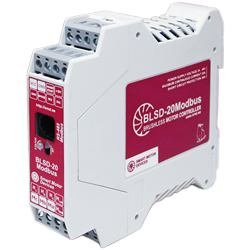Simple and reliable BLDC motor control with BLD‑20DIN and BLSD‑20Modbus controllers - control the motor for any purpose - Smart Motor Devices develops and takes care of the hardest part, the user applies it easily and wherever it is convenient.

BLDC motors are one of the most common types of electric drive in industry, both for positioning and speed control. But it is common that users need not just control, but also some additional functionality. Additional features can be designed and implemented by a user, but this can be difficult or time consuming, especially for non‑experts. It is much more convenient if the device already offers all the necessary functions. And it’s even better if the user does not require special knowledge or complex device setup. Smart Motor Devices develops electric drive control devices following this concept - complex and sophisticated controllers offer full functionality and ease to use.
For which motors? For DC brushless motors with Hall sensors up to 1000W power
In order not to complicate the system and make it as simple as possible to use and at the same time reliable and trouble‑free without increasing the cost of the final device, the developers of Smart Motor Devices follow a simple principle - for each motor type and power there is its own controller model.
In this review, we want to present two models of controllers designed specifically for three-phase DC brushless motors with Hall sensors, power up to 1000 W: BLD‑20DIN and BLSD‑20Modbus.
Controller models and their functionality
BLD‑20DIN and BLSD‑20Modbus controllers are designed for speed control and/or position control of DC brushless motors.
The most requested functionality for such devices:
- Speed regulation;
- Position control;
- Smooth, adjustable acceleration and stopping;
- Limiting the maximum current and output torque of the motor to protect both the motor itself and the surrounding mechanics;
- Adding security features;
- Additional inputs for motion control.
Position control is only available in BLSD‑20Modbus controllers as the BLD‑20DIN does not have an interface to specify a target position. BLSD‑20Modbus can perform movement to a given coordinate, relative displacement by a given amount, and can also calculate and determine the target position when using program mode.
Speed control is implemented in both controller models using an analog voltage signal. The motor speed is proportional to the input signal 0 to 5V.
BLD‑20DIN controllers also provide speed adjusting with a built‑in potentiometer. The regulation function with a built‑in potentiometer is in demand, mainly, for test runs of the drive, when there is no master control PLC yet. And also it is useful for applications when the speed is adjusted once and does not change during operation - this allows to reduce the cost of additional system elements.
BLSD‑20Modbus controllers additionally provide the ability to set the speed via RS‑485 Modbus, as well as programmatically calculate the desired speed value depending on some external conditions. For example, different speeds for movement in forward and reverse directions, or changing speed according to external discrete signals.
Smooth acceleration and deceleration in BLD‑20DIN is determined by the position of the trimming resistor on the front panel of the controller. The controller BLSD‑20Modbus provides a special Modbus register for this purpose.
The maximum current limit is set in the range from 1 to 20A. This allows to safely use the BLD‑20DIN and BLSD‑20Modbus controllers with motors of different power without the risk of damage due to overload.
To implement the safety function on the user side, both models have a special discrete input HARD_STOP. During normal operation of the system, there is a signal at the input (closed to the GND terminal of the controller). In the event of an accident, the HARD_STOP connection circuit is opened - the controller will immediately stop the motor and go into emergency mode.
Additional discrete inputs provide control of motor start and stop, and can also be programmed in BLSD‑20Modbus controllers for any other purposes. We also provided a possibility to change the logic of the inputs – the input signals can be processed as per a front of a signal or as per a level.
Adaptation to operate with motors from different manufacturers
The design and parameters of motors from different manufacturers and different models can vary greatly. We have provided the ability to connect motors with different numbers of poles, with different locations (and therefore counting directions) of Hall sensors. Also, for more convenient speed control with an analog signal, we have provided scalability and adaptation of the rated speed of the motor and the analog signal. For our controllers, it does not matter what the rated speed of the motor is - from 1000 to 20,000 rpm the user will have a full range of speeds set using an analog signal.
Final result
As a result, Smart Motor Devices offers excellent models to control BLDC motors, which are:
- cost‑effective;
- user friendly and easy to use;
- full‑functional for motion control;
- equipped with protection and a reliable device.

